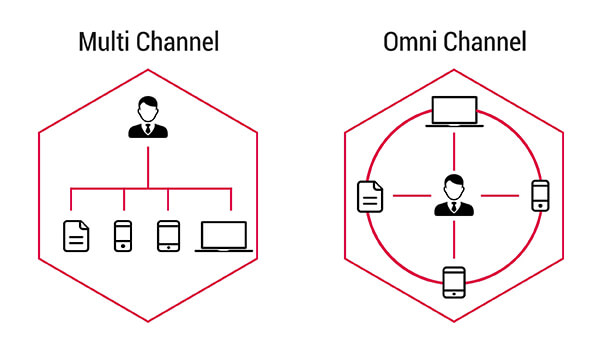
It’s no secret that today’s consumers are largely using the internet as a starting point in their buyer’s journey. This offers a great opportunity for marketers to strategically get their brands in front of prospective customers. However, between optimizing your Facebook page and streamlining your inbound marketing process, it might feel a bit like you’re trying to be all things to all people. With new marketing trends seeming to pop up every time you blink, at no time has that sentiment been more true for marketers than now. Accordingly, when you hear the term omni-channel marketing, we can only imagine that your first thought is, “great, yet another marketing buzzword.” After all, isn’t omni-channel the same thing as multi-channel?
Not exactly.
Multi-channel marketing uses various marketing channels such as email, social media, and SMS as separate entities geared towards connecting with prospective customers chiefly through their preferred method of communication. Omni-channel marketing takes these different marketing approaches and uses them in a way where they work collectively to make the customer experience seamless across different channels.
Here’s an Example of Omni-Channel Marketing:
Your best friend is getting married so you hop on your laptop computer to search through her online registry to find the perfect gift. Just as you decide on what to buy and put the item in your shopping cart, you get a phone call. Distracted, you forget to check out.
Later that evening you’re playing around on Facebook using your tablet when you see an ad from that company displaying the very item you have in your shopping cart. You click on the link and to your surprise, you’re taken right back to your shopping cart. Now, upon second review, you’re not so sure this is the gift you want. You’ll figure it out tomorrow.
While at work the next day you get an e-mail from the company offering you 15% off your next purchase if you sign up for their new mobile app. After signing up, you decide to stop by the brick and mortar store on your way home from work, since you pass right by one on your commute anyway. Once in the store, you’re able to use the mobile app on your cell phone to manage your virtual shopping cart, adding items by merely scanning their barcodes. The 15% off coupon, which is connected to your mobile app, automatically deducts the discounted amount as you go. You discover that one of the items that you want is not in stock and search for an associate to help you. Armed with an ipad “cash” register that doubles as a product management tool, the associate is able to locate the product at a nearby store and have it shipped directly to your best friend’s address, along with your other gifts.
And there you have it.
Omni-channel marketing is becoming more widespread, with businesses and organizations of all sizes using it to streamline their processes and be as accessible as possible for clients and customers. As demonstrated above, this approach can be invaluable in helping a customer along their buyer’s journey.
Getting Started
Is your company considering implementing omni-channel marketing or have you recently implemented this strategy? Share your thoughts in the comment section below.
To learn more, download our new whitepaper, “Getting Started with Omni-Channel Marketing:”
